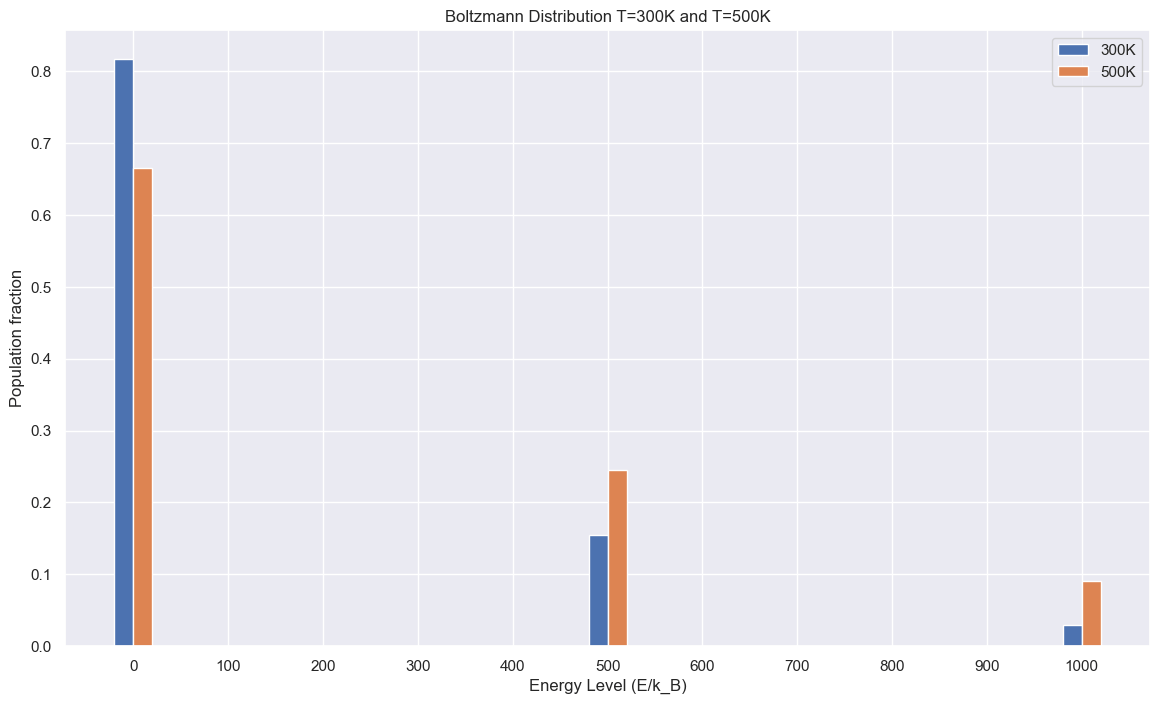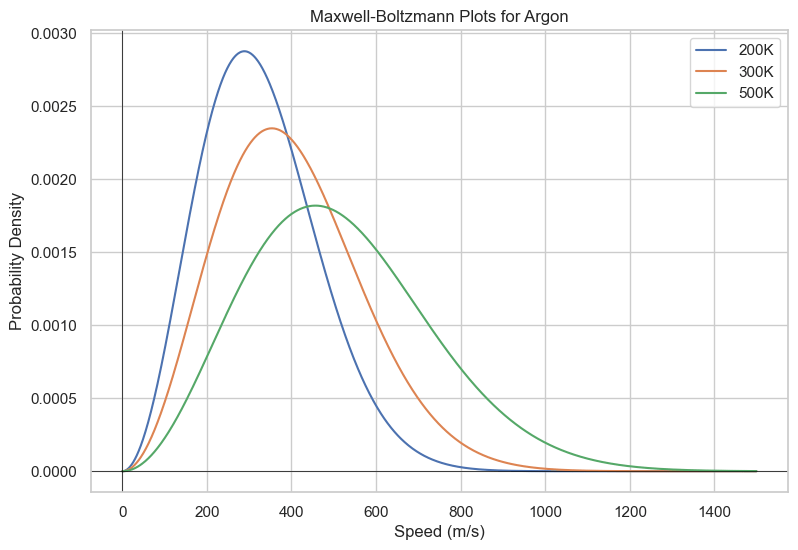energy_levels = [0, 500, 1000] # energy levels in multiples of k_B
def GetBoltzmann(E,T):
# k_B = 1.38e-23
k_B = 1
return np.exp(-E/(k_B*T))
def GetQ(array,T):
accum = 0
for item in array:
accum += GetBoltzmann(item,T)
return [GetBoltzmann(E,T) for E in array]/accum
plt.figure(figsize=(14,8))
width = 20
plt.bar([i-width/2 for i in energy_levels],
GetQ(energy_levels, 300),width=20)
plt.bar([i+width/2 for i in energy_levels],
GetQ(energy_levels, 500),width=20)
plt.xlabel("Energy Level (E/k_B)")
plt.ylabel("Population fraction")
plt.xticks([100*i for i in range(0,11)])
plt.title("Boltzmann Distribution T=300K and T=500K")
plt.legend(["300K","500K"])
plt.show()
Statistical Mechanics
Introduction
Refresher on Microstates and Macrostates
- Microstates: These are the different possible arrangements of particles in a system.
- Macrostates: These represent the overall, macroscopic state of the system, described by properties such as pressure, volume, and temperature. Each macrostate corresponds to multiple microstates.
Entropy
Boltzmann Definition of Entropy
The Boltzmann definition of entropy is $$S=k_B \ln W$$ where S is entropy, \(k_B\) is Boltzmann's constant, and W is the number of microstates.Boltzmann Distribution
Equilibrium
We previously went over microstates in the probability chapter. A system at equilibrium has states that are populated proportional to $$p(a)= \frac{e^{-\frac{E_a}{k_BT}}}{Q}$$ where p(a) is the population of a microstate a, \(E_a\) is the energy level of state a, \(k_B\) is Boltzmann's constant (\(1.38\times 10^{-23}\)J/K), T is temperature, and Q is a normalization factor. Sometimes we will instead write the denominator for the exponent as $$\beta = \frac{1}{k_BT}$$ We can also describe the ratio of how populated two microstates are by $$\frac{p(a)}{p(b)}=e^{-\frac{E_a-E_b}{k_BT}}$$ We can write this without a proportionality as the normalization factor cancels out. This implies that two microstates with the energy are equally populated at equilibirium. It also states that microstates at lower energy will be more populated than high energy microstates. Why is the Boltzmann distribution what we observe for a system? The derivation is beyond the scope of this text, but the Boltzmann distribution maximizes total entropy (not system entropy).Multiplicity
What the Boltzmann distribution gave us was a way to relate populations of microstates, but what about states? Let us consider a two level system.- 1 ground state (G) - Energy=0
- 2 excited states (A and B) - Energy=E

Maxwell-Boltzmann Distribution
So we've seen that the Boltzmann distribution makes lower energy microstates more populated. Does this mean that lower energy states are always more populated? The answer is not necessarily; higher energy macrostates can be more populated if there are more microstates than there are in the lower energy levels and you are at a sufficient temperature. One example is how speed for molecules are distributed, called the Maxwell-Boltzmann distribution. The multiplicity for the number of microstates for a given speed is proportional to the square of the speed, as it is like the surface area of a sphere of radius v, where v is the speed. $$f(v)=(\frac{m}{2\pi k_BT})^{3/2}\times(4\pi v^2)\times\exp(-\frac{m}{2k_BT}v^2)$$ While the distribution may not initially appear like a Boltzmann distribution, this is because it is parameterized in terms of speed. By using the kinetic energy equation $$K=\frac{1}{2}mv^2$$ You recover the familiar decaying exponential. The resulting distribution is shown below.
def Maxwell_Boltzmann(x,T, m):
if type(x) == np.array or type(x) == list:
return np.array([Maxwell_Boltzmann(i,T,m) for i in x])
k_B = 1.38e-23
return (m/(2*np.pi*k_B*T))**(3/2)*(4*np.pi*x**2)*np.exp(-m*(x**2)/(2*k_B*T))
v_array = [i for i in range(0,1500)]
m_argon = 1.6605e-27*39.89
plt.figure(figsize=(14,8))
plt.plot(v_array,Maxwell_Boltzmann(v_array,T=200,m=m_argon))
plt.plot(v_array,Maxwell_Boltzmann(v_array,T=300,m=m_argon))
plt.plot(v_array,Maxwell_Boltzmann(v_array,T=500,m=m_argon))
plt.title("Maxwell-Boltzmann Plots for Argon")
plt.xlabel("Speed (m/s)")
plt.ylabel(f"Probability Density")
plt.legend(['200K','300K','500K'])
plt.show()
Heat Capacity
In order to calculate the average energy of the system, we can take the expected value of the energy $$\lt E \gt=\sum_{\nu}E_{\nu}P(\nu)$$Linear Response Theory and Fluctuation-Dissipation Theory
Linear Response Theory (LRT) is a framework used to study the behavior of systems subjected to small external perturbations. In essence, it assumes that the response of a system to a small external force is linear, and it is particularly useful in understanding how systems react to external stimuli near equilibrium.The Fluctuation-Dissipation Theorem (FDT) establishes a connection between the linear response of a system to external perturbations and the statistical properties of thermal fluctuations at equilibrium.
It can be shown that $$\lt E \gt = -\frac{\partial \ln Q}{\partial B}$$ By taking the second derivative of Q with respect to beta, it can be further shown that $$\text{Var}(E)=K_BT^2\frac{\partial \lt E \gt}{\partial T}$$
Concentration and Its Effect
$$\Delta G = \Delta G^0 + RT \ln(Q)$$ where Q is the current concentration for the equilibrium K expression.Imagine a reaction of an ion going from one area to another with the two concentrations being different. $$Ca^{2+}_{\text{left}}\rightleftharpoons Ca^{2+}_{\text{right}}$$ Since there is no actual chemical reaction, \(\Delta G^0=0\) However, since the concentrations are different $$Q=\frac{[Ca^{2+}_{\text{right}}]}{[Ca^{2+}_{\text{left}}]}$$ Therefore, we can give the Gibbs Free Energy change for a concentration cell as $$\Delta G=RT\ln Q$$
Equilibrium and Gibbs
We are given \(\Delta G^0=-RT \ln(K)\) Equilibirium is reached when dG=0. $$0=-RT\ln(K)+RT\ln(Q)$$ Since log is a bijective function, we can conclude that equilibrium is reached when $$Q=K$$Statistical Mechanics Exercises
- What are microstates and macrostates? How do they relate to the concept of entropy?
- How does the Boltzmann distribution relate to the concept of equilibrium in statistical mechanics?
- Explain the significance of the Boltzmann factor and how it influences the distribution of particles in different energy states.
- How do temperature and molecular mass affect the shape of the Maxwell-Boltzmann distribution?
- Given the Maxwell-Boltzmann distribution, calculate the most probable speed, the average speed, and the root-mean-square speed of the molecules in a gas at a specified temperature.
- Explain the difference between the Maxwell-Boltzmann distribution and the Boltzmann distribution.
- Consider a two-state system with energy levels \(E_1\) and \(E_2\). Derive the expressions for the probabilities of each state and the average energy in terms of the Boltzmann distribution.
- Can a system have negative absolute entropy? Justify your answer using the principles of statistical mechanics.
- Define and explain the significance of degeneracy in the context of the Boltzmann distribution.
- Derive a discrete Maxwell-Boltzmann distribution for a three state system where \(E_1=1k_BT,E_2=2k_bT,E_3=4k_BT\). The multiplicities are given by the same way as the continuous case (i.e. proportional to the speed squared, or proportional to E).